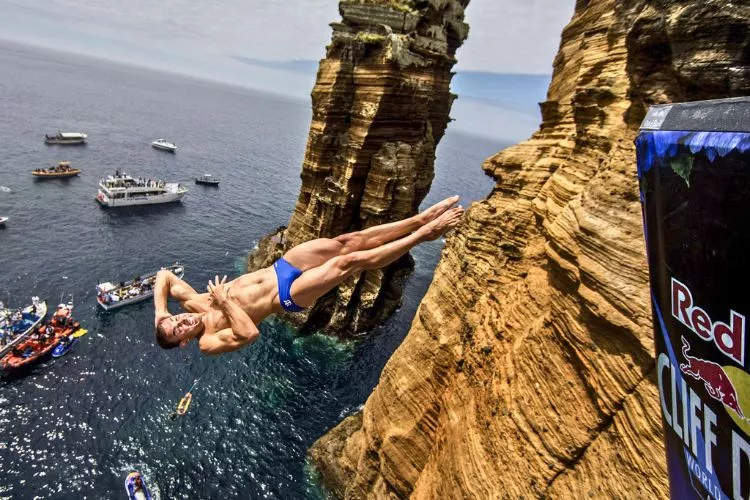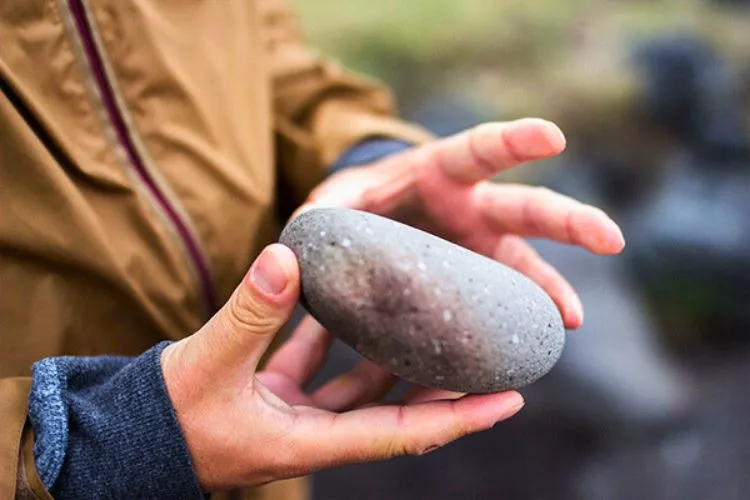Cliff jumping is an exhilarating pursuit where thrill-seekers leap from towering cliffs into the water below.
But, have you observed that these audacious adventurers often throw rocks before their dive?
So, why do cliff jumpers throw rocks?
Well, this ritual isn’t whimsical, and instead serves a practical purpose which I will cover here.
This article unfolds the intriguing reason behind ‘rock throwing,’ a seemingly inconsequential act that’s often overlooked but is intrinsically woven into the fabric of safe cliff jumping.

Join us as we plunge into the depths of this fascinating practice.
Why do cliff jumpers throw rocks?
Cliff jumpers often throw rocks into the water from the jumping point for two primary reasons: to gauge the depth of the water and to check for any hidden obstacles submerged below the surface.
The depth of the water source is integral to the safety of the jump. Jumping into a water source that’s too shallow can lead to serious injury or fatality.
The rock’s speed and floating trajectory provide an estimate of the water’s depth.
Furthermore, throwing a rock allows the jumper to check if there are any unseen obstacles like rocks, debris, or underwater wildlife – all of which can pose a significant threat to the jumper’s safety.
Thus, this simple act of ‘rock throwing’ plays a fundamental role in reducing risk and ensuring safer jumps.
Does throwing a rock break surface tension?
Yes, throwing a rock into the water does indeed break the surface tension. This behavior serves a practical purpose during cliff jumping or when any object falls onto water from a significant height.
Surface tension can make water behave nearly like a solid under certain conditions, which is why it’s sometimes described as “hitting concrete” when falling from extreme heights into water.

Rocks or any other objects falling into the water create a sort of “path” by disrupting the surface tension.
This pathway through the water’s surface tension can theoretically reduce the sudden deceleration experienced when landing on calm water, making a jump or fall less dangerous or less painful.
However, it’s important to note that there are more factors in play when jumping from a significant height into water, and breaking the surface tension by throwing a rock ahead does not guarantee safety.
The overall depth of water, presence of underwater obstacles, and the jumper’s ability to enter the water smoothly, are among the significant factors affecting the safety of a jump.
Why do cliff divers throw a towel?
Cliff divers may throw a towel, or more specifically, a small, highly absorbent towel known as a “shammy,” into the water before their jump for a few reasons. First, the towel can help them gauge the distance to the water.
Due to water’s transparent nature, it can sometimes be difficult to estimate the distance accurately.

Second, they may utilize the towel after the jump to dry off quickly since a shammy is designed to be wrung out and reused immediately, making it perfect for multiple dives.
Although these towels are not specifically aimed at breaking the surface tension of water or checking for underwater obstacles, they serve a practical purpose during a dive and offer utility to the cliff divers.
Please note that throwing a towel before jumping might be more prevalent among swimmers and competitive divers, as seen in some of the source materials, than it is among cliff divers specifically.
In short, cliff jumping needs certain level of assurance and inspection in order to do it rightly. It’s an exciting sport, but it can create a mess as well, if we don’t take precautions beforehand.
Frequently Asked Questions (FAQs)
Why do cliff divers land feet first?
Answer: Cliff divers typically land feet first to minimize the risk of injury and ensure greater safety during the jump. Feet-first entry minimizes the contact area with water and better distributes the force of impact. A head-first entry, much like a traditional dive, significantly increases the risk of head, neck, and spinal injuries due to the sudden deceleration and higher water resistance. Hence, landing feet first allows divers to safely descend and avoid severe injuries.
How fast are cliff divers going when they hit the water?
Answer: The speed at which cliff divers hit the water depends on the height of the jump and the individual diver’s form during the fall. Generally, cliff divers reach speeds of around 50-60 miles per hour (80-97 km/h) when they impact the water.
However, this speed can vary based on several factors, such as wind resistance and body positioning. Higher falls result in faster speeds, making the impact with the water more forceful and dangerous.
What does it mean when water has a high surface tension?
Answer: High surface tension implies that the water molecules at the surface possess a strong cohesive force, adhering closely to one another. This cohesion forms a thin, almost elastic “film” at the surface, which allows certain lightweight objects or insects to float without breaking the surface tension. High surface tension makes water more resistant to external forces or objects trying to penetrate it, and as a result, can cause a harder impact when jumping or falling into it.
Why do divers break the surface tension?
Answer: Divers aim to break the surface tension in order to mitigate the force of the impact with the water. Water’s high surface tension can cause resistance that feels almost like a solid surface when landed on, especially from significant heights. By breaking the surface tension—for example, by throwing a rock or creating a splash—the water becomes less resistant, allowing a smoother entry, and reducing the risk of injury or discomfort during the dive.
Conclusion:
The practice of throwing rocks before a cliff jump serves a crucial safety purpose. By gauging the water depth and ascertaining the absence of submerged obstacles, cliff jumpers minimize the risk of injury or fatality.
Additionally, breaking the surface tension of water can potentially lessen the impact force, further safeguarding the adrenaline seekers.
Ultimately, this seemingly small ritual highlights the importance of adopting safety measures even in the high-stakes world of extreme sports, ensuring that thrill-seekers make responsible decisions while pursuing their exhilarating adventures.


